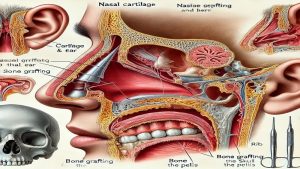Techniques, bond resources and challenges
Introduction
Nasal reconstruction is one of the most sophisticated and delicate plastic surgery aimed at improving respiratory function and nasal aesthetic function.. This procedure is usually in cases of congenital defects, trauma, complications of previous surgeries (Like unsuccessful rhinoplasty) Or destructive diseases (Like granulomatosis) Done. Since the nose has a complex and complex structural nose, its reconstruction requires the use of suitable transplanted materials to rebuild the skeletal framework.. In this article from the site of Dr. Behnam Khorrami (Isfahan nose surgeon _ Jaw surgeon of Isfahan), To check the use of cartilage (Of the nose blade, ear or ribs) And bone (Of the skull or pelvis) We discusrate in rebuilding nasal structure.
Anatomy of the nasal structure
The nose consists of three main parts:
- Bone section: Included.
- The cartilage section: Includes lateral cartilage, septum (Septum) And the cartilage of Alar (Nose wings).
- Softening: Includes skin and subcutaneous tissues that cover the entire nasal structure.
Nose regeneration usually on the skeletal framework (Cretishing and bone) Focuses because these sections are responsible for supporting the shape and function of the nose.
Reasons for the need for nose reconstruction
1. birth defect
Choanal atresia
Cleft lip and palate (Harelip)
Cretishing anomals
2. Trauma and damage
Nasal bone fracture
Damage to Septum And lateral cartilage
3. Previous surgery complications
Nasal deformity after rhinoplasty
Excessive rhinoplasty (Over-Resection)
4. Autoimmune infection
Granulomatosis
Syphilis
Emotion
5. Malignancy
Cobalt cell carcinoma
Melanom
Cartilage and bone sources for nose regeneration
1. Rather, it is enlarging the nose by creating a bridge over the nose
Cartilage due to high flexibility and resistance to re -absorption (Resorption) Used as the main substance in nose reconstruction. The main sources of cartilage bonding are:
(A)) Nasal blade cartilage (ШіЩҫШӘЩҲЩ…)
The best option for regeneration, because of the proper strength and shape
Good molding capability
Limited risk for re -absorption
Limit: In the event of previous surgeries, there may not be sufficient tissue
(B)) Ear cartilage (Ear Conkai)
Because of high flexibility and easy access
Suitable for rebuilding nose and delicate structures
Limit: Has less strength than septum cartilage
Ш¬) Gear cartilage
The most powerful and strongest option
Suitable for rebuilding a large framework or in case of severe destruction
Limitations:
Possibility of torsion (Warpage)
Surgical incision in the gear area may cause pain and discomfort
2. Bone grafting
Bone in cases where the need to rebuild the hard structure (Such as bone nose) There is, it is used. The main sources of bone transplantation are:
(A)) Skull bone (Caloria)
Flat and strong structure
High resistance to absorption
Limit: Need complex surgical technique to harvest
(B)) Pelvic bone (Elim)
Bone marrow
High strength and adaptation to the nasal structure
Limit: The possibility of pain and discomfort after harvest
Reconstruction surgery techniques
1. Reconstruction of nasal septum
Use of septum cartilage to repair deviation or defect
If septum cartilage is not available, ear or gear cartilage is used
2. Reconstruction of the Alar structure (Nose wings)
Ear or gear cartilage is commonly used to regenerate alarms
If needed to be more robust, Gear cartilage Used as a reinforcement
3. Reconstruction of the bone part of the nose
In severe fractures, the skull or pelvis is used
A combination of cartilage and bone is used to improve the shape and height of the nose bridge
4. Nasal regeneration
Ear cartilage is commonly used to regenerate the tip of the nose because of its high flexibility
In cases of further consistency, gear cartilage is selected
Challenges and problems of nose regeneration
вң… Religious cartilage torsion
The gear cartilage is prone to twist after transplantation
The use of stabilization techniques with suture or small plates is helpful
вң… Attraction (Resorption) Cartilage or bone
Nasal blade cartilage and skull bone have the least chance of absorbing
Ear cartilage and ribs are more prone to absorbing
вң… Not comparing
Need for accurate molding of bonds
Precision stabilization and symmetry techniques

Conclusion
Nasal reconstruction using cartilage and bone transplantation is an effective and advanced way to correct nasal structural defects.. The selection of transplantation depends on several factors, including defects, surgical history, and the need for strength or flexibility.. Septom cartilage is the first choice due to its high strength and compatibility. In the absence of septum cartilage, ear or rib cartilage, and in cases of larger defects, bone transplants from the skull or pelvis are good options..
Useful links:
Isfahan nose surgeon _ Jaw surgeon of Isfahan
Dr. Behnam Khorrami's page in the clinic 24 | Maxillofacial surgeon in Isfahan clinic 24 | Nose surgeon in Isfahan clinic 24
Dr. Behnam Khorrami, nose surgeon in Isfahan at Dr. Af | Maxillofacial surgeon in Isfahan at Dr. Af | Isfahan nose surgeon at Dr. Af